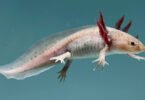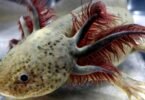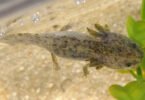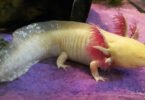Welcome to the fascinating world of the Axolotl, a creature as mysterious as it is marvelous. Known scientifically as Ambystoma mexicanum, these unique and exotic amphibians have amazed scientists and animal lovers alike with their extraordinary ability to regenerate lost body parts.
In this blog post, we will delve into axolotl biology, habitat, care and maintenance in captivity, and axolotl’s conservation status, uncovering this remarkable creature’s secrets.
Table of Contents
Scientific Classification of Axolotl (Ambystoma mexicanum)
| Domain: | Eukaryota |
| Kingdom: | Animalia |
| Phylum: | Chordata |
| Class: | Amphibia |
| Order: | Urodela |
| Family: | Ambystomatidae |
| Genus: | Ambystoma |
| Species: | Ambystoma mexicanum |
Species Overview
| Common Name: | Axolotl, Mexican Walking Fish |
| Scientific Name: | Ambystoma mexicanum |
| Type: | Amphibians |
| Diet: | Carnivore |
| Average Lifespan in the Wild: | 10 to 15 years |
| Size: | Up to 12 inches |
| Weight: | 2.11 to 8 ounces |
| IUCN Red List Status: | Critically endangered (CR) |
| Current Population Trend: | Decreasing |
What is an Axolotl?
An Axolotl (scientific name: Ambystoma mexicanum) is a unique type of salamander, notable for its extraordinary ability to regenerate lost body parts. Unlike most amphibians, axolotls do not undergo metamorphosis from a larval stage to an adult form; they remain aquatic and retain their gills throughout their life, a condition known as neoteny. This means they live in water their entire life and do not develop the lung-breathing adult stage like other salamanders.
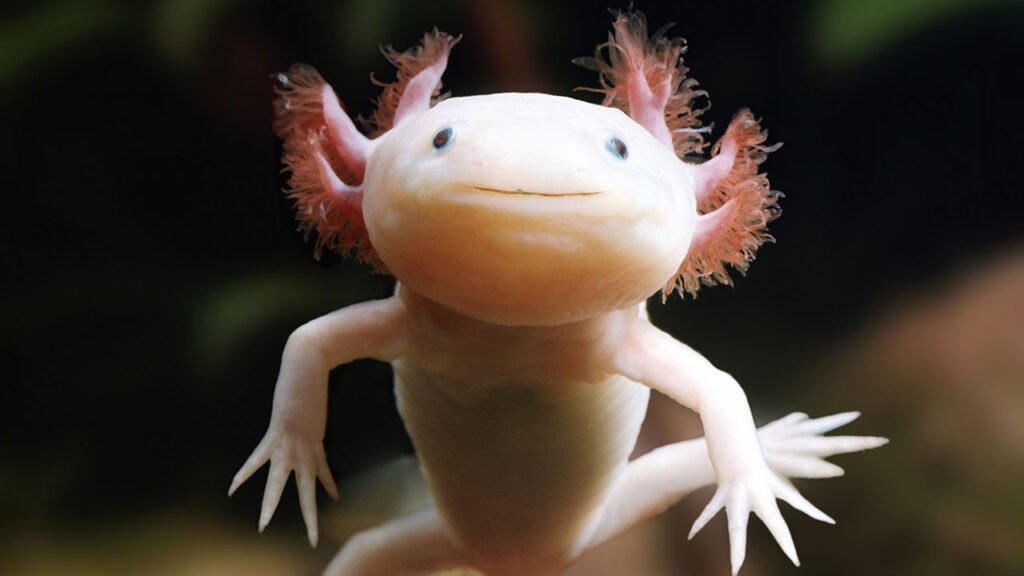
Native to the lake complex of Xochimilco near Mexico City, these creatures are critically endangered in the wild, primarily due to habitat loss and pollution. Axolotls are characterized by their wide heads, lidless eyes, and external gill stalks, which give them a distinctive and somewhat otherworldly appearance. They come in various colors, from wild-type green to albino and leucistic (pink with black eyes).
Axolotls are a popular subject of scientific research due to their regenerative abilities. They can regrow entire limbs, parts of their heart, spinal cord, and even portions of their brain without scarring, an ability that is rare in the animal kingdom and of great interest to medical science, especially in the field of regenerative medicine.
In addition to being studied in laboratories, axolotls are also kept as exotic pets. They require specific aquatic conditions in captivity, including cool, clean water and a diet of worms, insects, and small fish. Despite their popularity in aquariums, the conservation of their natural habitats and wild populations remains a significant concern.
Axolotl Anatomy
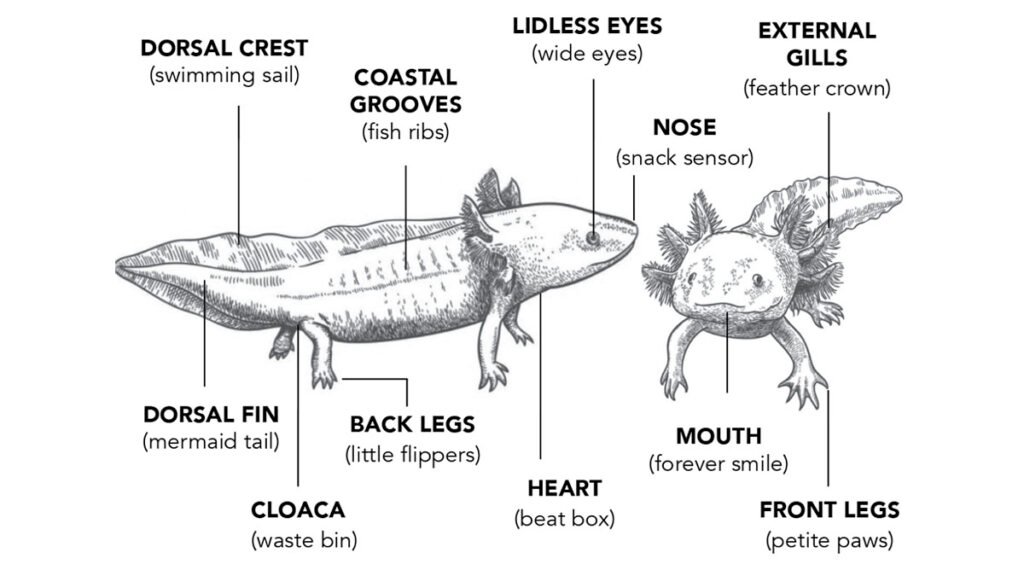
Axolotl Color Morphs
Axolotls are known for their fascinating variety of color morphs, each resulting from specific genetic mutations. These morphs do not impact the axolotl’s health or behavior but offer a diverse range of appearances for enthusiasts. Here are some of the most popular axolotl color morphs:
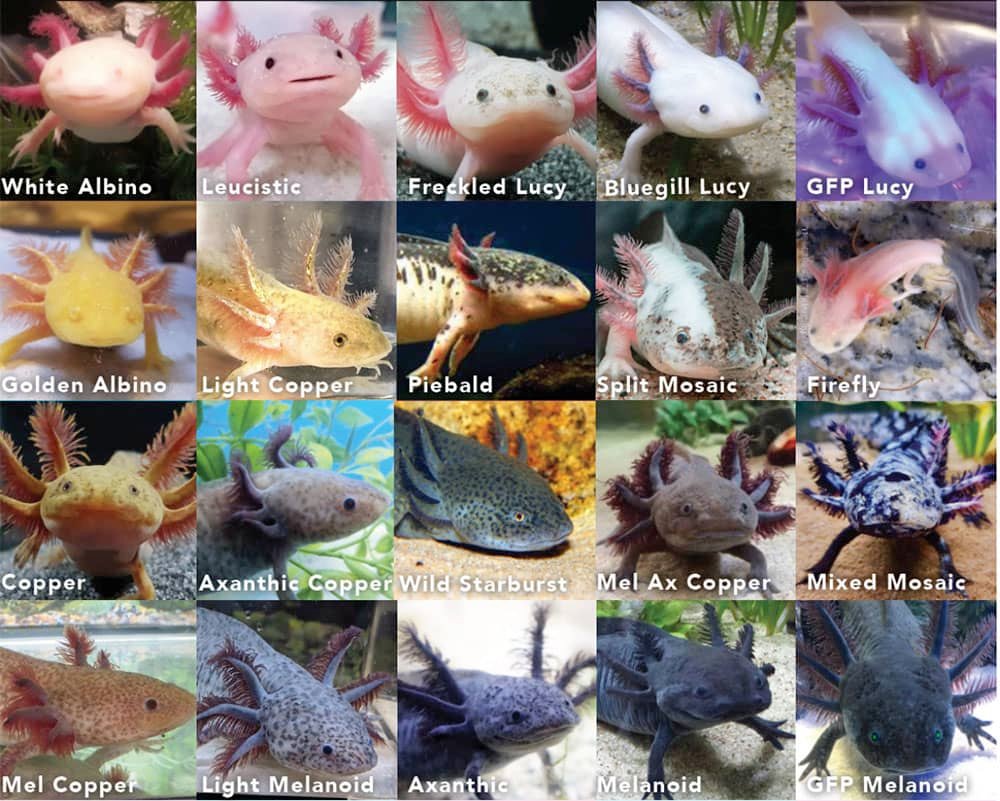
- Wild Type: This morph closely resembles the natural appearance of axolotls in the wild. They have a dark coloration, usually ranging from greenish-brown to black, with gold speckling and a lighter belly.
- Leucistic: Often mistaken for albino, leucistic axolotls have a white or pink body with black eyes. They are one of the most popular morphs due to their striking appearance.
- Albino: True albino axolotls lack pigmentation, giving them a white or pinkish color and red eyes. There are two main types of albino axolotls: golden albino, which has a yellowish tone, and white albino, which is paler.
- Melanoid: This morph has an increased amount of melanophores, resulting in a uniform dark black coloration. Melanoid axolotls lack both shiny gold speckling and a lighter-colored belly.
- Axanthic: Axanthic axolotls lack yellow pigmentation, giving them a grey or brownish appearance. They can have various shades, often combined with other morphs for unique looks.
- Copper: A relatively rare morph, copper axolotls have a unique coppery color, sometimes with a metallic sheen. They can have varying shades from light gold to deep copper.
- GFP (Green Fluorescent Protein): These axolotls have been genetically modified to express a green fluorescent protein, making them glow under ultraviolet light. GFP can be present in any morph, adding a unique luminescent quality.
- Chimera and Mosaic: These are very rare and occur due to genetic anomalies. Chimeras have two different sets of DNA, often visibly split down the middle of the body, while mosaics have a patchwork of colors due to cells with different genetics.
Each axolotl color morph offers a unique and visually striking appearance, making them highly sought after by hobbyists and pet owners alike. However, it’s important to note that regardless of their color, all axolotls require the same level of care and attention to thrive in captivity.
Axolotls Housing Requirements
Housing axolotls properly is crucial for their health and well-being. Here are the key requirements for axolotl housing:
- Tank Size: A single axolotl needs at least a 20-gallon tank. If you plan to keep more than one, you’ll need a larger tank to provide adequate space and prevent territorial stress.
- Water Quality and Filtration: Axolotls are sensitive to water quality. The tank should have a filtration system to keep the water clean but with minimal current, as axolotls prefer still water. Regular water changes are also essential.
- Temperature: The ideal water temperature for axolotls is between 60-64°F (16-18°C). They are cold-water animals and can become stressed by temperatures that are too warm. You may need a cooler or a fan to maintain the right temperature, especially in warmer climates.
- Lighting: Axolotls do not require special lighting. However, you might need lights to support plant growth if you have live plants in the tank. Axolotls prefer dimmer conditions, so avoid bright lights.
- Substrate: Fine sand is the best substrate for axolotls, as it reduces the risk of impaction that can occur with gravel. Alternatively, the tank can be left bare, though this might not be as aesthetically pleasing.
- Decor and Hiding Places: Axolotls need hiding spots to feel secure. You can use aquarium-safe decorations, plants (either live or artificial), or caves. Ensure that all decorations are smooth and free of sharp edges to prevent injuries.
- Tank Mates: Axolotls are best kept alone or with other axolotls of similar size. They should not be housed with fish or other aquatic creatures, as these can harm the axolotl or become its prey.
- Lid: A secure lid is essential to prevent the axolotl from jumping out of the tank, which they can occasionally do.
Axolotl Behavior and Temperament
Axolotls display a range of fascinating behaviors and possess a temperament that makes them unique both in their natural habitat and as pets.
In the wild, Axolotls are mostly nocturnal, showing increased activity during the night. They tend to be solitary, only coming together for breeding purposes. Their natural behavior involves spending much of their time at the lake’s bottom or concealed among aquatic plants. Hunting is a key part of their behavior, where they use a suction technique to quickly open their mouths and ingest prey like worms, insects, and small fish.
When axolotls, such as in-home aquariums, are kept in captivity, their behavior can slightly adjust. Although they are naturally more active at night, they can adapt to the presence of humans and may become more active during the day. Axolotls are generally calm creatures and exhibit no aggressive behavior towards humans.
In an aquarium setting, they enjoy exploring their environment but often prefer staying near the bottom. These creatures are known to recognize feeding routines and may show increased activity or come to the water surface when it’s time to eat.
The temperament of axolotls is generally docile. They are not territorial, which allows for keeping multiple axolotls in the same tank as long as there’s ample space and no competition for food. Unlike pets that interact more with humans, axolotls are more of a species to be observed. They require very gentle and minimal handling due to their delicate nature, and excessive handling can cause them stress.
Habitat and Lifestyle
The axolotl, a creature of still-water environments, is native to only two lakes in Mexico: Lake Xochimilco and Lake Chalco. In these habitats, they face the critical threat of extinction due to pollution, habitat degradation, and water diversion, largely caused by the expanding human population in the area.
Despite their cute appearance and small teeth, axolotls are efficient predators. They feed on worms, mollusks, crustaceans, insect larvae, and small fish. During the day, they hide in aquatic vegetation and mud for protection; at night, they actively hunt for food. While they primarily breathe through their gills, axolotls occasionally surface for a quick breath of air.
Diet and Nutrition
When it comes to feeding axolotls in captivity, their diet can be a subject of study. One investigation compared the growth rates of juvenile axolotls on different diets: exclusively bloodworms, solely Daphnia (a small aquatic crustacean), or a mix of both. The study found that axolotls grew fastest on a bloodworm diet and slowest on a Daphnia diet, with mixed diets resulting in moderate growth. This suggests that a varied diet might not be as beneficial for axolotl growth as a consistent, high-quality one.
Axolotls feed using suction and consume worms, tadpoles, insects, and small fish. They may also ingest gravel, which aids in grinding up food in their stomach, similar to how birds use grit.
Reproduction in Axolotls
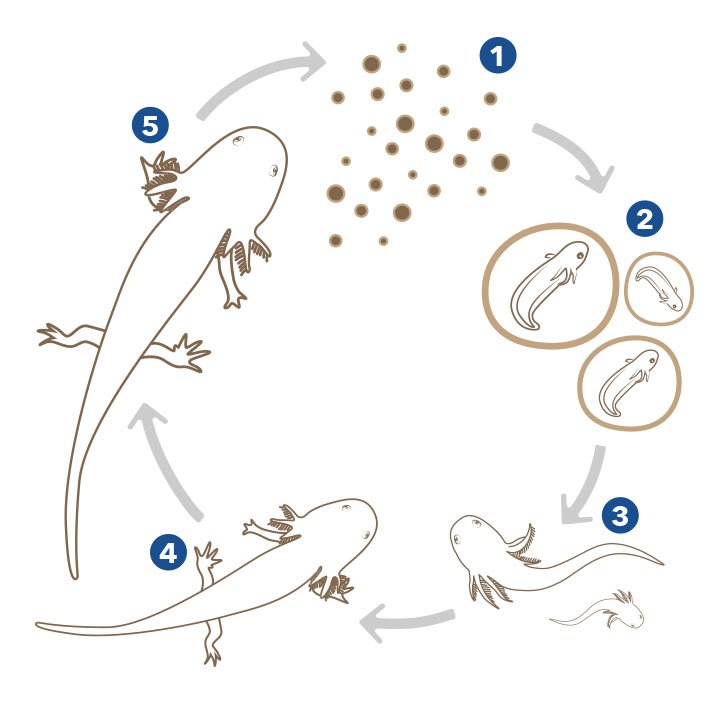
Axolotls reach sexual maturity by six months of age. Axolotls usually live alone but come together to mate when they’re about a year old, followed by a breeding season between March and June, when water temperatures and levels are more temperate. In their native habitat, axolotl spawn in February. The male does a special dance, shaking his tail, to get the female’s attention. She lets him know she’s interested by gently bumping him with her nose.
Then, the male leaves tiny sperm packets on the lake floor. The female picks these up to fertilize her eggs. She can lay hundreds of eggs, often around 300, sticking them to plants or rocks to keep them safe from other animals. In about two weeks, these eggs hatch into tiny axolotls that swim off on their own. They don’t get any help from their parents.
Axolotls always look like they’re young because they live in lakes that don’t dry up. Other amphibians change as they grow to live on land, but axolotls don’t need to because they always have water. This is why they keep their youthful, tadpole-like tails.
Common Health Problems
Axolotls, like any pet, can encounter various health problems, especially when their living conditions are not optimal. Some of the most common health issues they face include:
- Water Quality Issues: Poor water quality is a leading cause of health problems in axolotls. They are sensitive to ammonia, nitrites, and high nitrate levels, which can lead to stress and illness. Regular water changes and proper filtration are crucial.
- Fungal Infections: Axolotls are prone to fungal infections, which often appear as white, cottony growths on their skin or gills. These infections are usually caused by poor water conditions or injury.
- Bacterial Infections: These can manifest in various ways, such as skin ulcers, redness, or swelling. Bacterial infections are often a result of unsanitary tank conditions or injuries.
- Impaction: This occurs when an axolotl eats substrate material (like gravel) that it cannot digest, leading to a blockage in its digestive system. Using fine sand or keeping the tank bottom bare can prevent this.
- Metabolic Bone Disease: This is caused by insufficient calcium or vitamin D3 in their diet, leading to weakened bones. A balanced diet and proper nutrition are essential to prevent this.
- Temperature Stress: Axolotls prefer cooler water temperatures (around 16-18°C or 60-64°F). Temperatures that are too high can stress them and lead to health issues.
- Ammonia Poisoning: High levels of ammonia in the water can burn an axolotl’s skin and gills, leading to severe stress and potential death. Regular water testing and maintenance are important to prevent this.
- Parasites: Axolotls can be susceptible to internal and external parasites, which can cause weight loss, lethargy, or unusual behavior.
It’s important for axolotl owners to maintain a clean and well-regulated environment for their pets and to provide a diet that meets all their nutritional needs. Regular observation for any signs of distress or illness is crucial, and prompt consultation with a veterinarian specializing in exotic pets is advised if any health issues arise.
Axolotls in Captivity
In recent years, Axolotls have become popular as exotic pets. Pet axolotls are popular in China and Japan. They come in various colors, from wild-type green to albino and leucistic (pink with black eyes). Keeping an Axolotl requires a well-maintained aquarium with cool, clean water, as they are sensitive to temperature and water quality. Diet in captivity usually consists of bloodworms, brine shrimp, and special amphibian pellets.
Conservation Concerns
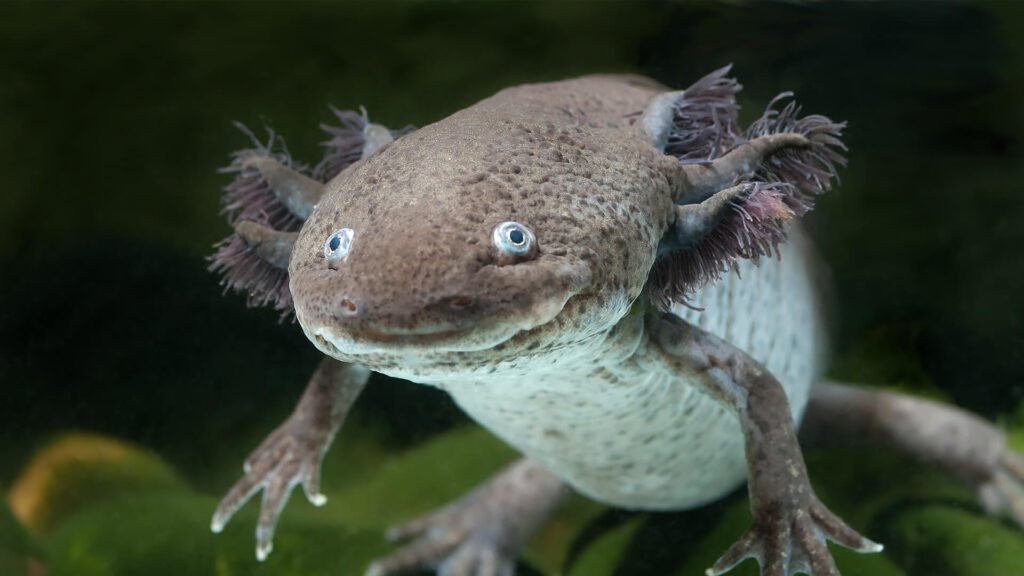
Despite their popularity in captivity, Axolotls face critical threats in the wild. Classified as Critically Endangered, their survival is jeopardized by habitat loss due to urbanization and pollution in their native Mexican waters. Axolotls reside in a couple of freshwater lakes right in the heart of Mexico City, the world’s largest city. The competition for this vital freshwater increases as the human population grows, and pollution further threatens these unique salamanders.
In an effort to reverse their declining numbers, conservationists are stepping in to aid the axolotl. They’re creating special “shelters” in Xochimilico, assembling rock piles and planting reeds to naturally filter and clean the water that’s pumped into these habitats.
Conservation efforts are ongoing, with various programs aimed at preserving their natural habitat and breeding them in captivity.
Is It Legal to Own a Pet Axolotl?
The legality of owning an Axolotl pet varies by location, and it’s essential to be aware of these regulations before considering an Axolotl as a pet. In the United States, Axolotls are illegal to own in certain states, such as California, Maine, New Jersey, and Virginia. In New Mexico, owning an Axolotl is legal, but importing them from other states is not. These restrictions are often in place due to environmental concerns, the risk of non-native species becoming invasive, or issues related to the conservation of native wildlife.
Axolotls are native to Mexico and are currently listed as critically endangered species, primarily due to habitat loss, declining water quality, and urbanization. It’s important to note that wild Axolotls should never be captured and kept as pets. The pet trade relies on Axolotls that are captive-bred, often descending from individuals originally used in scientific research.
If you’re considering an Axolotl as a pet, it’s crucial to check your local exotic pet laws to ensure that you can legally keep one. This ensures you comply with the law and supports these unique creatures’ responsible and ethical keeping.
Similar Species to the Axolotl
If you’re interested in similar pets, check out:
- Tiger Salamander
- Leopard Gecko
- Fire Belly Newt
Otherwise, check out all of our other reptile and amphibian profiles.
Axolotl Facts – Did You Know?
- An Axolotl, often nicknamed the “Mexican Walking Fish” by Australians and New Zealanders, is actually not a fish.
- The first living axolotls arrived in Paris in 1864, 150 years ago.
- Axolotls are illegal to own in some U.S. states for the reason they will be poached from the wild.
- Axolotls have amazing regenerative abilities, and they are able to heal limbs, hearts, spinal cords, and brain parts without scarring.
- The axolotl genome is the second longest in the animal kingdom, with 32 billion base pairs. That’s 10 times as long as the human genome.
- Newly hatched axolotls, hungry for their first meal, will sometimes snack on their siblings’ limbs. They grow back, after all.
- The word “axolotl” comes from the Nahuatl language of the Aztecs, and means “water dog.” Its mythological connection is to Xolotl, the god of fire, lightning, deformities, and death.
- The Spanish word for axolotl is ajolote, but is used colloquially in Mexico to encompass all forms of salamander. It is also called the Mexican walking fish (though it is not a fish at all).
- The axolotl is part of the group of mole salamanders—which includes its closest relative, the tiger salamander Ambystoma tigrinum; and the more distant relative, the spotted salamander Ambystoma maculatum.
FAQs – Frequently Asked Questions
Are Axolotl Amphibians?
The Axolotl, often nicknamed the “Mexican Walking Fish” by Australians and New Zealanders, is actually not a fish. This intriguing creature is an amphibian, specifically a type of salamander. Despite its fish-like appearance, the Axolotl is a distinct member of the amphibian family.
Can Axolotl Live With Fish?
Keeping Axolotls with fish is not recommended due to different dietary needs, potential harm to Axolotl’s delicate skin and gills, and the risk of predation or stress. Axolotls also require specific water conditions that might not be suitable for many fish species. Additionally, there’s a risk of disease transmission. For these reasons, Axolotls are best housed in their own species-specific tank.
Are Axolotl Freshwater?
Yes, Axolotls are freshwater animals. They naturally inhabit freshwater lakes and canals, specifically in the lake complex of Xochimilco and formerly in Lake Chalco, near Mexico City. Axolotls have adapted to living in freshwater environments and require freshwater to survive.
Can Axolotl go on Land?
Axolotls are fully aquatic animals and cannot survive on land. Unlike some other salamanders that undergo metamorphosis to develop lungs and live on land, axolotls retain their larval features throughout their lives, a condition known as neoteny. This means they have gills for underwater breathing and lack the developed lungs and sturdy limbs necessary for terrestrial living.
Are Axolotl Hard to Take Care of?
Taking care of an Axolotl is moderately challenging and requires specific attention to their environment and diet. They need a well-maintained aquarium with specific water conditions, including a cool temperature (around 60-64°F or 16-18°C), good filtration to keep the water clean, and a pH level that’s carefully monitored.
Are Axolotl Salamanders?
Axolotls, often mistaken for fish, are actually a type of salamander. They are easily recognizable by their wide heads, lidless eyes, and feathery gills that protrude from both sides of their head, giving them a distinctive and somewhat alien appearance.


